Review of Houthi anti-ship weapons and assessment of their effectiveness

After Israel launched a military operation against the Palestinian movement Hamas, the Yemeni Islamist group Ansar Allah, better known as the Houthis, from the beginning of October 2023 with the help of shock drones and missiles attack commercial and military ships in the Red Sea.
The Houthis have declared that they entered the war on the side of Hamas and say they only target ships calling at Israeli ports or those whose owners have ties to Israel.
The Houthi attacks have severely hampered international shipping and a number of companies have announced they will no longer send their ships through the Bab al-Mandeb Strait, which connects the Gulf of Aden to the Red Sea and is one of the most important shipping lanes.
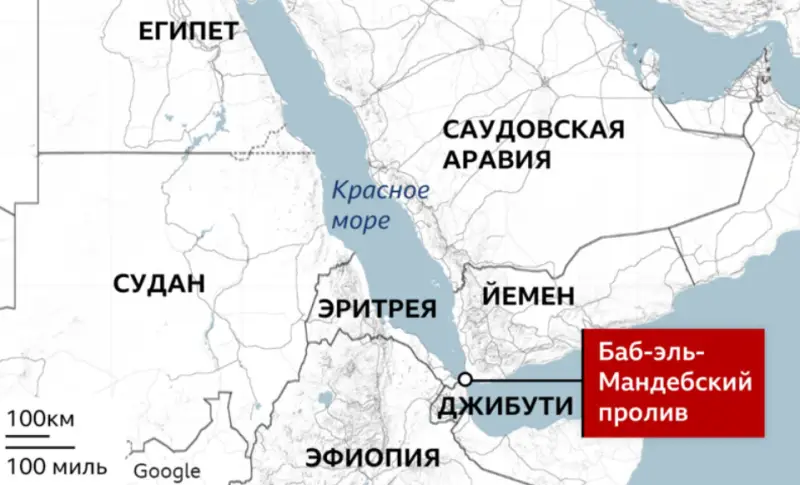
It should be understood that when sending goods along bypass routes, delivery times and costs inevitably increase, for which end consumers, including those in Russia, ultimately pay out of their own pockets.
Relatively recently, over a glass of tea, one of my good friends, who has long worked for the Rosneft company on Sakhalin, was interested in what anti-ship weapons that could cause damage to tankers carrying Russian oil do the Houthis have, how dangerous they are, and how this can be counteracted. Since this topic is very extensive, I decided to devote a separate publication to it.
In their first attacks, the militants landed on the decks of ships from helicopters and tried to capture them using small boats. It is known that the Houthis are trying to use unmanned speedboats to block shipping, but the greatest danger is posed by unmanned aerial vehicles and anti-ship missiles.
The main supplier of anti-ship weapons for the Houthis it is Iran. Also in Yemen, samples of Soviet and Chinese production, legally acquired before the start of the civil war in this country, could remain.
Attack unmanned aerial vehicles
The armed forces of the Ansar Allah group have at their disposal more than ten types of unmanned aerial vehicles of various configurations, including disposable ones drones-kamikazes, attack drones capable of carrying missiles and light bombs, as well as vehicles designed for reconnaissance and surveillance.
In the past, Qasef-1 and Qasef-2K UAVs, identified as Iranian Ababil family drones, were used to strike targets controlled by the anti-Houthi Arab coalition forces in Yemen and Saudi Arabia.
In Iran, since 1999, devices of this type have been mainly used as aerial targets for training air defense crews. But according to information published in English-language sources, the Houthis tried to use these drones, equipped with a passive radar seeker or a video camera with image broadcast equipment and remote control, against the radars of the Saudi Patriot air defense systems and attacked the Al-Anad airbase in Yemen, occupied by Arab coalition forces.
The Qasef-1 UAV is built according to a canard design and has a thin elongated fuselage 2,9 m long, a slightly swept front horizontal tail and a wing with a span of up to 3,25 m. The fuselage and wing are made of composite materials. Approximately 20 HP piston engine. With. with a pushing propeller in the rear fuselage provides a speed of about 200 km/h. Flight duration is 1,5 hours, range is at least 120 km. The ceiling reaches 3 km. A warhead weighing up to 40 kg is used to hit a target.
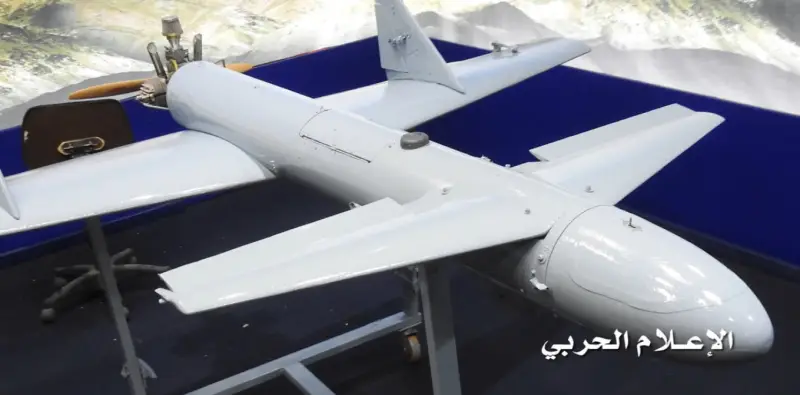
UAV Qasef-1
There is no doubt that a remotely controlled aircraft with such characteristics could pose a serious threat to civilian ships.
Samad-2 and Samad-3 drones have been used repeatedly in the past to attack targets in Saudi Arabia, Israel and the UAE. On November 29, 2023, the US destroyer USS Carney (DDG-64) in the southern Red Sea shot down a Samad-3 UAV that was launched from Houthi-controlled territory in Yemen and was heading towards the supply ship USNS Supply (T-AOE-6).
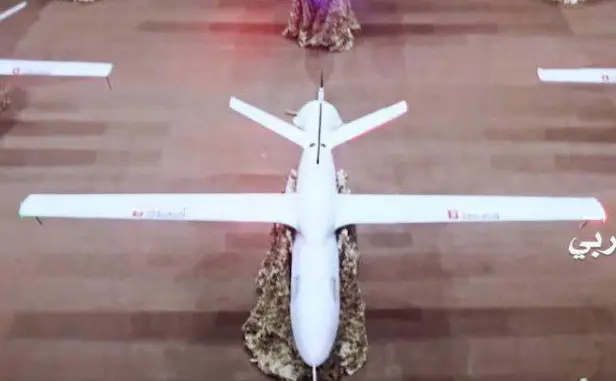
UAV Samad-2
The length of the Samad-2 UAV is 2,8 meters, the wingspan is 4,5 meters. It has a distinctive v-tail and is equipped with a pusher propeller driven by a Chinese DLE 170 engine with 17,6 hp. With. Maximum speed – up to 200 km/h. Flight range is about 1 km. Samad-200 can carry both reconnaissance equipment and a warhead weighing 2 kg.
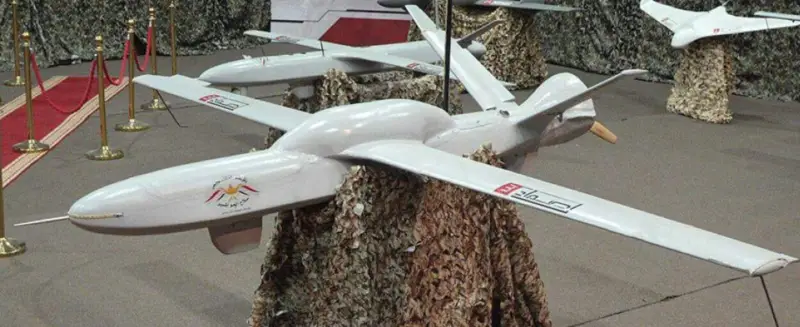
UAV Samad-3
The Samad-3 UAV differs from the previous model by a conformal fuel tank mounted on the top of the drone. With a flight range of up to 1 km, the mass of the explosive charge can reach 500 kg.
An attack drone capable of carrying unguided missiles and bombs is the Samad-4. Previous Iranian Samad-type drones were intended for reconnaissance or had a warhead in the body.
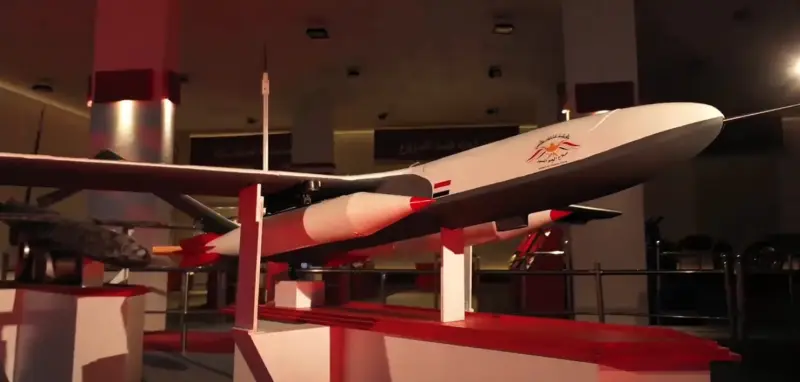
UAV Samad-4
Open sources say that the Samad-4 UAV has increased dimensions and a more powerful engine compared to previous models.
The Houthis also have a Shehab UAV at their disposal. Its exact data and purpose are unknown.
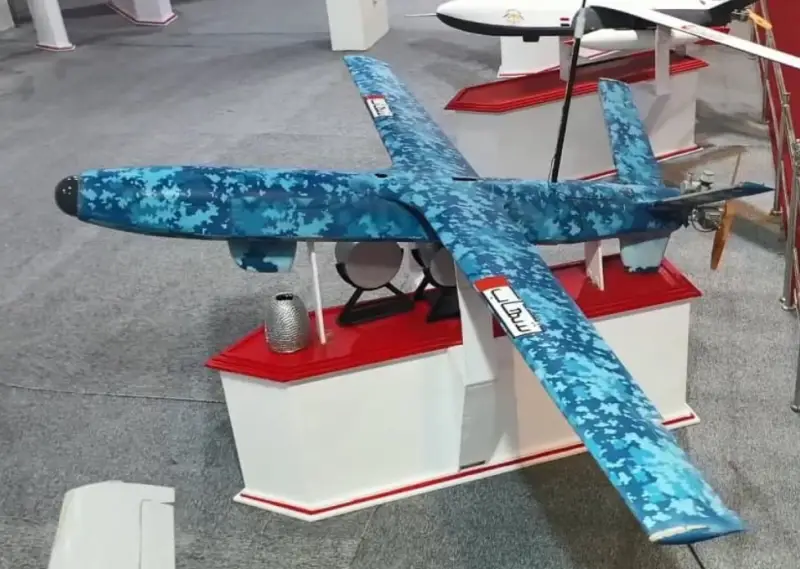
UAV Shehab
It is believed that this is a reconnaissance drone with a range of up to 50 km, which is also capable of carrying a combat load and being used as a loitering munition.
The device with the Yemeni designation Waaed is nothing more than the Iranian Shahed-136.
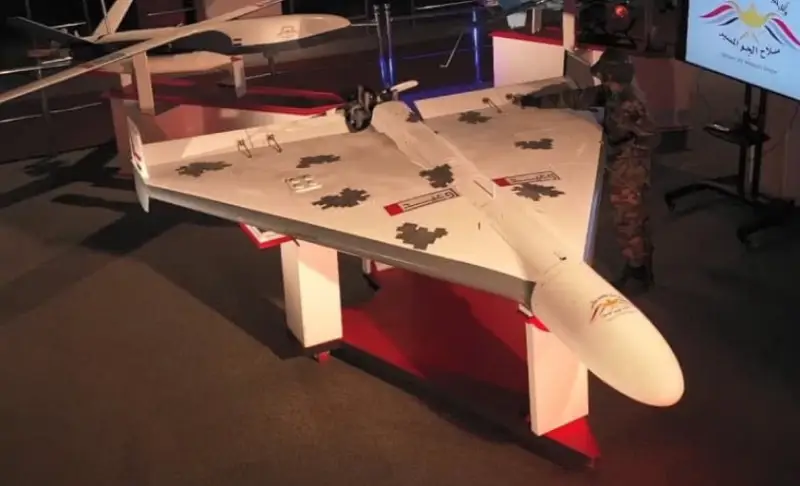
UAV Waaed
The characteristics of this tailless kamikaze drone are well known. With a mass of about 200 kg, its flight range exceeds 1 km. Flight altitude: 000–50 m. Length – 4 m. Wingspan – 000 m. Iranian-made MADO MD 3,5 two-stroke piston engine provides a cruising speed of 2,5–550 km/h.
In 2021, the Houthis demonstrated the Khatif-1 television-guided loitering munition with a range of several tens of kilometers.
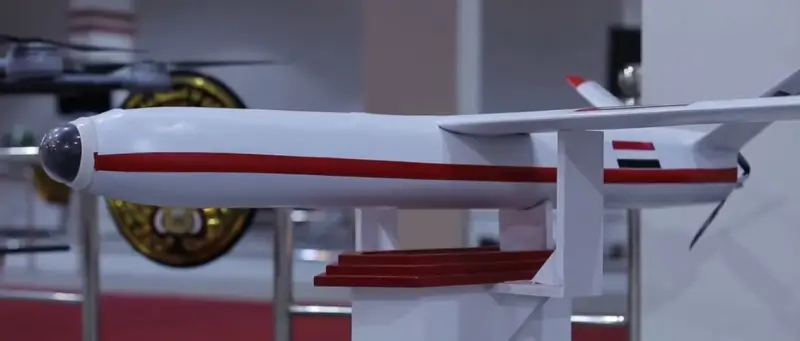
Khatif-1
An improved modification, known as Khatif-2, appeared in 2022. The data of this remote-controlled kamikaze drone is not disclosed. According to estimates, it is equipped with a warhead weighing up to 10 kg.
Anti-ship cruise missiles
During the Soviet era, the Yemeni Navy received a small missile ship, Project 1241.1 Molniya, and two missile boats, Project 205 Moskit. The Soviet MRK and RK were armed with P-22 anti-ship missiles (export version of the P-15M) with a firing range of about 40 km.
Yemen also had several coastal missile systems with Chinese S-201 anti-ship missiles (a further development of the P-15), supplied by Iran. During the Iran-Iraq War, Iran acquired them from China. Anti-ship missiles, which received the designation “Silk Warm” in the West, were actively used during combat operations. In the late 1980s, Iran established its own production of S-201 missiles.
Today, the P-22 and S-201 anti-ship cruise missiles with engines running on liquid fuel and oxidizer, which trace their lineage back to the P-15 anti-ship missile, which appeared in 1959, are absolutely archaic. Thanks to larger capacity tanks, the flight range of the Chinese S-201 increased to 100 km. At the same time, the increase in the supply of fuel and oxidizer on board has led to an increase in the dimensions of the rocket and excludes the possibility of placement on boats.
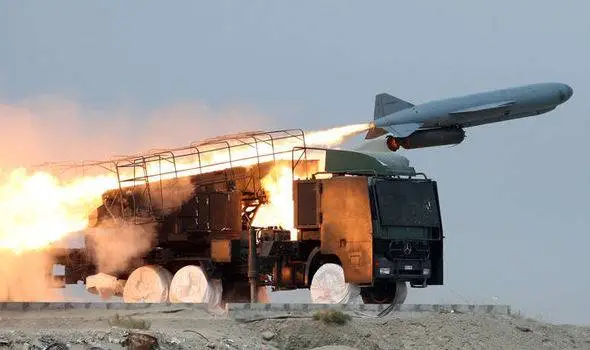
The missile carries a heavy armor-piercing high-explosive warhead weighing 513 kg, but due to the subsonic flight speed and low noise immunity of the active radar seeker, its effectiveness in modern conditions is low. In addition, when refueling a rocket, the crew is forced to work in protective suits and insulating gas masks.

Anti-ship missiles C-201
Despite the low performance characteristics and operational problems, the Houthis regularly display the S-201 in parades, and military experts believe that this old anti-ship missile poses a certain danger to commercial fleet.
In 1995, China supplied Yemen with three Type 037IG missile boats with YJ-8 solid-fuel anti-ship missiles (export designation C-801), which are close in characteristics to the first versions of Exocet anti-ship missiles.
The boats themselves were sunk as a result of Saudi strikes. aviation, but the missiles apparently were saved, and the Al-Mandab-1 coastal defense complex was made on their basis.

Al-Mandab-1 anti-ship missiles
The maximum firing range of Al-Mandab-1 missiles when launched from a mobile coastal launcher does not exceed 40 km. The guidance system is active radar. The flight speed of the anti-ship missiles is subsonic.
For all their advantages, solid-fuel missiles, as a rule, are inferior in launch range to missiles with ramjet and turbojet engines. Therefore, using the aerodynamic design and guidance system of the YJ-8, the PRC created the YJ-82 (S-802) anti-ship missile with a compact turbojet engine. The range of the new missile has more than doubled. The first C-802 anti-ship missiles arrived in Iran in the mid-1990s along with Chinese-made missile boats. Soon, Iran began independently assembling missiles. The Iranian version of the S-802 was named Noor.
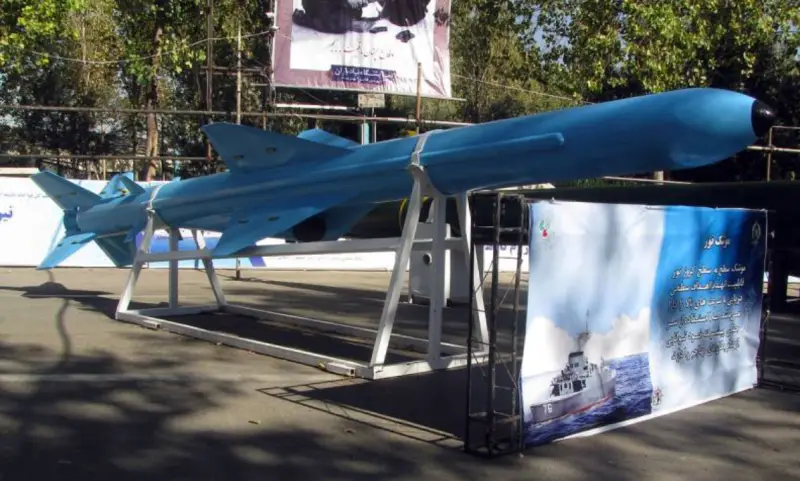
RCC Noor
In terms of weight and size characteristics, range and flight speed, the Nur anti-ship missile system is in many ways similar to the American RGM-84 Harpoon, but to what extent the noise immunity and selectivity characteristics correspond to the American model is unknown.
A longer-range option is the Iranian Ghader anti-ship missile, created on the basis of the Chinese C-803 with a firing range of up to 250 km.

Al-Mandab-2 anti-ship missiles
This missile is equipped with a more economical turbojet engine, a larger capacity fuel tank and an armor-piercing high-explosive warhead weighing 185 kg. The Houthis gave this anti-ship missile the name Al-Mandab-2.
In 2019, the Houthis demonstrated the Quds-1 cruise missile, which appears to be a modification of the Iranian Soumar missile. The creation of the Soumar missile launcher became possible after Ukraine sold the Soviet X-55 air-launched missile launcher to Iran.
Presumably Quds-1 is a simplified version of the Soumar missile launcher, developed in Iran for wartime production. The Yemeni missile has a shorter flight range and its wing is not foldable.

Quds-1 cruise missile
The reference books say that the Quds-1 missile launcher is mainly intended for attacks on stationary objects. Its flight range is 150 km. The rocket is powered by an unlicensed version of the TJ-100 compact turbojet engine developed by the Czech company PBS Velká Bíteš with a thrust of up to 1 N, which provides a speed of about 250 km/h. Length – 800 m. Case diameter – 5,6 mm.
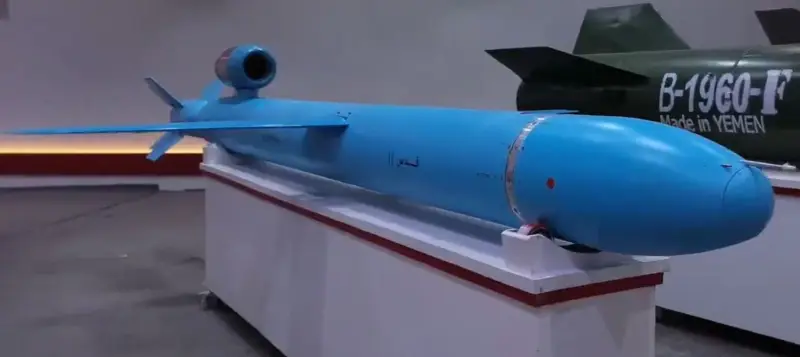
Anti-ship missiles Quds-2
The Quds Z-0 missile, created on the basis of a modified Quds-2 missile launcher (appeared in 2021), received an electro-optical system and can be used against surface targets.

Anti-ship missiles Quds Z-0
It is believed that the latest modification of Quds-3 has a firing range of more than 800 km, but what guidance system is installed on it is not known for certain.
In 2022, the Houthis also unveiled a relatively compact anti-ship cruise missile called the Sahil.

Experts believe that this is an Iranian light anti-ship missile Fajr Darya, copied from the Chinese FL-6 missile. In turn, the FL-6 appeared after Chinese specialists gained access to the compact Italian anti-ship missile system Si Killer. These relatively small and inexpensive anti-ship missiles are designed to combat “mosquito fleet” ships with a displacement of up to 1 tons and counter amphibious operations in the coastal zone. Their firing range is approximately 000 km. Sahil missiles can be equipped with a TV or IR seeker. With a launch weight of 40 kg, the rocket carries a 300 kg warhead.
In the late 1980s, on the basis of the American AGM-65 Maverick air-to-surface missile, the YJ-7 (S-701) compact short-range anti-ship missile system was created in China. But, unlike the American prototype, the Chinese missile, in addition to helicopters and airplanes, can be used from portable launchers mounted on light boats and automobile chassis.
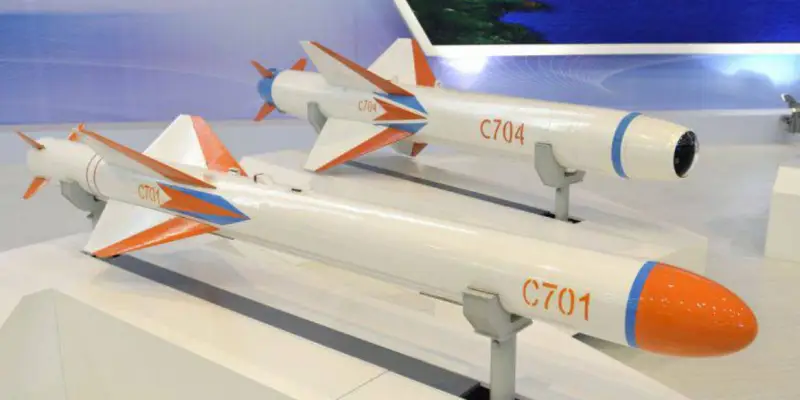
In 2008, at the 7th Zhuhai Air Show, the YJ-73 (S-703) anti-ship missile system with a millimeter-wave radar seeker was first demonstrated. Following it, the YJ-74 (S-704) and YJ-75 (S-705) missiles appeared with a television guidance system and a new radar seeker with increased noise immunity. The launch range of these modifications reaches 35 km.
YJ-7 missiles were delivered to Iran, from where they fell into the hands of militants of various Islamist groups and received a reputation as “guerrillas.” During the 2006 Lebanon War, a Chinese-made YJ-7 missile attacked the Israeli corvette Hanit. The ship was damaged, but remained afloat, and four crew members were killed. According to Western intelligence services, the Houthis also have these compact anti-ship missiles.
Anti-ship ballistic missiles
In the territories captured by the Houthis, the S-75M/M3 Volga air defense systems with the B-755 and B-759 missiles remained. In 2015, the Al-Masirah TV channel aired a story in which Qaher-1 tactical missiles were shown, converted from anti-aircraft missiles. It is reported that the work on the conversion of the missile defense system was carried out by the department of military industry of the army and people's committees.
Western experts believe that the Yemeni Qaher-1 was created in the model and likeness of the Iranian Tondar-69 missiles, and it was from Iran that the on-board control equipment, contact fuses and topographical reference equipment were supplied.
Back in 1989, Iran received from China 90 M-7 tactical missiles converted from the HQ-2 missile defense system (Chinese version of the S-75). Later, China provided documentation for converting anti-aircraft missiles into TR. In 1992, Iranian enterprises began serial production of the missile, designated Tondar-69. According to the Missiles of the World resource, as of 2012, Iran had 200 Tondar-69 missiles and 20 mobile launchers.
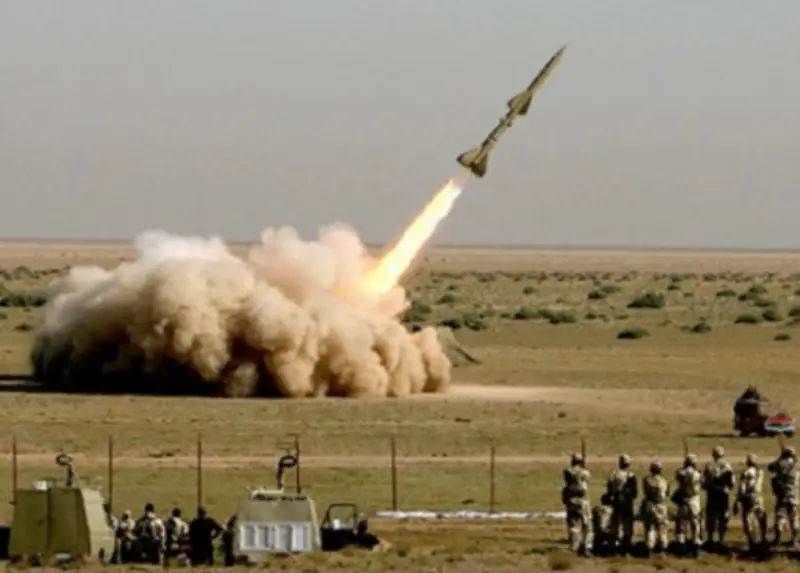
The launch of a Tondar-69 missile during a military exercise held in 2009
In 2017, Yemeni television showed footage of Qaher-M2 missiles. The declared launch range of the Qaher-M2 is 300 km, which, according to expert estimates, can be achieved by introducing a more powerful launch accelerator and reducing the mass of the warhead to 70 kg.
In total, the Houthis launched up to 60 Qaher-1 and Qaher-M2 missiles at the positions of the Arab coalition led by Saudi Arabia. The most famous incident involving the use of missiles of this type was the attack on the Khalid bin Abdulaziz airbase in Asir province in southwestern Saudi Arabia. The Saudis said that most of the Yemeni OTR were intercepted by Patriot air defense systems or fell in desert areas. In turn, the Iranian news agency FARS reported: “the shelling caused significant losses to the Saudi army.”

In 2022, the Houthis showed a Mohit ballistic anti-ship missile, created on the basis of a missile defense system, which, at the final stage of its flight, is aimed at the target’s thermal signature. At the same time, the search and capture of a large ship sailing with running engines is possible in an ellipse measuring 700x500 m.
The use of a missile, not much different from an anti-aircraft missile, as part of a tactical or anti-ship complex reduces the cost of production and maintenance and facilitates the training of personnel. However, the effectiveness of such weapons is highly questionable.
The missile carries a relatively light warhead, which is not powerful enough to effectively hit hardened targets. The large dispersion from the aiming point makes its use justified only against large area targets located in the front line: airfields, transport hubs, cities and large industrial enterprises.
At the same time, the effectiveness of an anti-ship ballistic missile with an infrared seeker, which captures a moving target on the descending branch of the trajectory in a short period of time, raises serious doubts. The separating first solid fuel stage when launching a rocket over the location of friendly troops can pose a danger.
Preparing a rocket with a liquid-propellant engine for combat use is a rather complex process. Since transporting a fully fueled rocket over long distances is impossible, oxidizer filling is carried out in the immediate vicinity of the launch position. After which the missile is transferred from the transport-loading vehicle to the launcher. It is clear that a missile battery, which contains bulky conveyors and tanks with flammable fuel and a caustic oxidizer that ignites flammable substances within the reach of enemy weapons, is a very vulnerable target.
Apparently, Iran and the leadership of the Ansar Allah group are relying on high-speed anti-ship ballistic missiles, allowing them to launch surprise attacks on sea targets appearing near the coast of Yemen.
In 2011, a towed launcher with the Khalij Fars anti-ship missile was demonstrated at Baharestan Square in Tehran. It is known that the Khalij Fars missile, controlled at the final stage of flight, is designed on the basis of the Fateh-110 ballistic OTR.
The ballistic anti-ship missile, whose name translates as “Persian Gulf”, has a firing range of about 200 km and is controlled by an inertial system for the main part of the flight. On the descending branch of the trajectory, guidance is carried out by an infrared homing head that responds to the ship's thermal signature or using a television radio command guidance system. Foreign observers indicate that these guidance systems are highly susceptible to organized interference and can be effective primarily against slow civilian vessels.
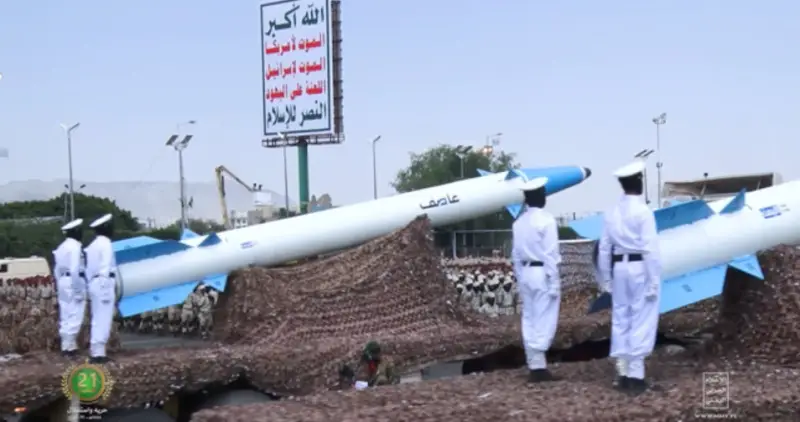
In Yemen, Iranian Khalij Fars missiles, designated Aasif', were displayed at a military parade in 2022.
Simultaneously with the Aasif anti-ship ballistic missile, the Tankil missile, created on the basis of the Iranian Raad-500 OTR with a firing range of up to 500 km, was demonstrated.
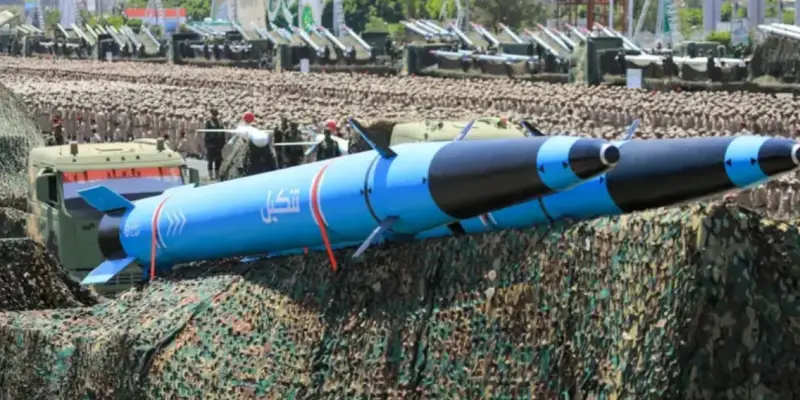
Five years ago, Iran tested the Fajr-4 light anti-ship missile. Sources write that it was originally created for launch from air carriers, but the Fajr-4CL modification, renamed Faleq-1 in Yemen, is intended for use from coastal launchers.
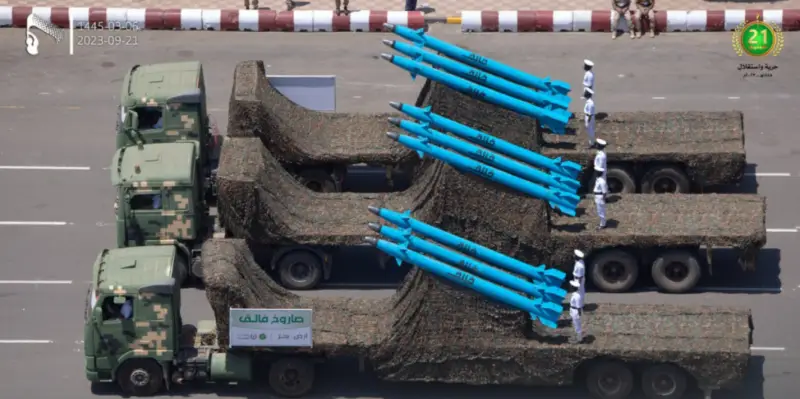
The missile with an optoelectronic camera and a command guidance system is capable of hitting targets at a range of about 50 km.
Assessing the effectiveness of Houthi anti-ship drones and missiles
As of mid-February 2024, the Houthis have used several dozen kamikaze drones, cruise and ballistic anti-ship missiles against foreign ships.
On December 15, 2023, two container ships were hit by missiles in the Red Sea, and a fire started on board. The ship Palatium III, owned by the Swiss company MSC, according to the US military, was hit by a ballistic anti-ship missile. In this case, the Houthis were the first in the world to achieve a ballistic missile hit on a ship in real conditions.
However, the effectiveness of Yemeni UAVs and anti-ship missiles is low. Slow and poorly maneuverable drones are a very easy target for shipboard air defense systems. They are also very successfully fought not only by carrier-based supersonic fighters F/A-18C/D Super Hornet, but also by subsonic attack aircraft of the Marine Corps AV-8B Harrier II, receiving target designation from the ship's Aegis system. Foreign authors write that in a number of cases, drone control systems were successfully suppressed by American AN/SLQ-32 naval electronic warfare equipment.
As for the Houthi anti-ship cruise missiles, they are still subsonic, and in most cases they are promptly intercepted by the RIM-156 (Standard-2ER Block IV), RIM-7P Sea Sparrow and RIM-162 ESSM missiles. However, on January 31, 2024, the Arleigh Burke-class guided missile destroyer USS Gravely (DDG-107) was forced to fend off an attacking anti-ship missile system using a 20-mm Mark 15 Phalanx CIWS close-in artillery system.
As already mentioned, the guidance systems of ballistic anti-ship missiles have a relatively narrow field of view and are capable of searching for targets only at the final stage of flight. Taking into account the fact that ballistic anti-ship missiles receive target designation before launch and for most of the flight are controlled by an inertial system, the error of which accumulates as the range increases, this reduces the effectiveness when firing at fast-moving objects. Most often, the target does not appear at the intended point. In addition, missiles flying along a ballistic trajectory, unlike low-altitude cruise anti-ship missiles, are usually detected by shipborne surveillance radars immediately after launch, and their predictable trajectory facilitates interception.
The Houthis' weakest link in countering shipping efforts since the US and UK began launching strikes in Yemen on January 12, 2024 has been intelligence. Aviation and Tomahawk cruise missiles destroyed or damaged control posts, communication centers, radars that controlled the sea area, positions of coastal missile systems, UAV bases and control stations.
Attempts to conduct reconnaissance using drones in most cases were promptly stopped, before patrol UAVs had time to issue target designations. The activation of “sleeping” radars on the shore was recorded by RTR means, after which bombs and missiles flew at them.
In the near term, we can expect the number of missile attacks on tankers and container ships off the coast of Yemen to decrease, but as an alternative, the Houthis could begin large-scale mine laying in shipping lanes.
Information